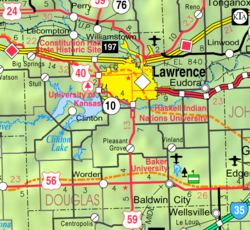Hesper, Kansas | |
|---|---|
 Hesper Friends Church, organized in 1858 | |
 | |
| Coordinates: 38°53′55″N95°04′29″W / 38.89861°N 95.07472°W [1] | |
| Country | United States |
| State | Kansas |
| County | Douglas |
| Elevation | 922 ft (281 m) |
| Time zone | UTC-6 (CST) |
| • Summer (DST) | UTC-5 (CDT) |
| Area code | 785 |
| FIPS code | 20-31550 [1] |
| GNIS ID | 479160 [1] |
Hesper is an unincorporated community in Douglas County, Kansas, United States. [1] It is located two and a half miles southeast of Eudora.


